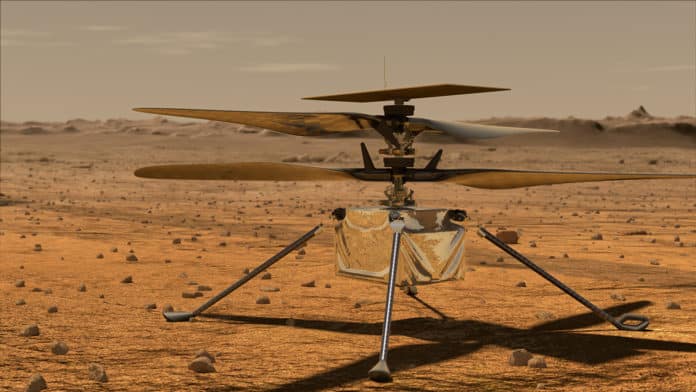NASA’s Ingenuity Mars helicopter was supposed to take to the Martian sky for the 14th time on September 18 and perform a brief hover flight that would have demonstrated the little chopper’s ability to fly with slightly higher rotor speeds. However, during its automatic pre-flight checkout, Ingenuity detected an anomaly in two of the small flight-control servo motors and aborted the operation.
Ingenuity was getting ready to begin flying with a higher rotor speed to compensate for decreasing atmospheric density caused by seasonal changes on Mars. Step one was to perform a high-speed spin test at 2,800 revolutions per minute (RPM) on the ground and, if everything went well, step two was to perform a short-duration flight at 16 feet (5 meters) altitude with a 2,700 RPM rotor speed rather than the usual 2,537 RPM.
On September 15, the Mars helicopter successfully completed the high-speed spin test. Ingenuity’s motors spun the rotors up to 2,800 RPM, briefly held that speed, and then spun the rotors back down to a stop, all exactly as sequenced for the test. The successful high-speed spin gave us the green light to proceed to a test flight with a 2,700 RPM rotor speed. At least, that was the plan.
After that, however, the Ingenuity Mars helicopter did not take off due to an anomaly with its two “servos,” electric position control devices that change the pitch of the rotors – and canceled the flight. While the servo motors are much smaller than the motors that spin the rotors, they do a tremendous amount of work and are critical to stable, controlled flight. Because of their criticality, Ingenuity performs an automated check on the servos before every flight. This self-test drives the six servos through a sequence of steps over their range of motion and verifies that they reach their commanded positions after each step.
The data collected by NASA shows that two of the upper rotor swashplate servos began to oscillate with an amplitude of approximately 1 degree about their commanded positions just after the second step of the sequence. Ingenuity’s software detected this oscillation and promptly canceled the self-test and flight.
Currently, NASA is testing the cause of the anomaly. To gather more data, the Ingenuity team executed additional servo wiggle tests during the past week, which were successful, meaning that the issue isn’t entirely repeatable.
“Our team will have a few weeks of time to complete our analysis because Mars will be in solar conjunction until mid-October, and we won’t be uplinking any command sequences to Ingenuity during that time,” wrote Jaakko Karras, deputy operations lead for the mission at NASA’s Jet Propulsion Lab. The conjunction is a special period in which Mars moves behind the Sun (as seen from Earth), making communications with spacecraft on Mars unreliable.
Now, all the mission team can do is wait and see how Ingenuity performs over an extended period of relative inactivity on Mars.
